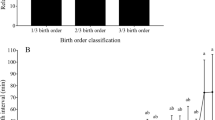Abstract
The present study investigated the incidence of postparturient disorders and backfat loss in primiparous and multiparous sows under tropical climates in relation to duration of farrowing and type of antibiotic used postpartum. In total, 81 sows (42 primiparous and 39 multiparous sows) were included. The sows were categorised according to the duration of farrowing into three groups: <2 (n = 58), 2–4 (n = 19) and >4 h (n = 4). According to the antibiotic used postpartum, the sows were divided into two groups: group I (enrofloxacin type 1, n = 36) and group II (enrofloxacin type 2, n = 45). Rectal temperature, the presence of abnormal vaginal discharge, the occurrence of postpartum dysgalactia syndrome (PDS) and the sows’ appetite were determined at days 0, 1, 2 and 3 postpartum. Backfat thickness was measured before farrowing and at 21 days postpartum. The mean duration of farrowing was 114.5 ± 60.2 min. Stillborn piglets in the sows with a long duration of farrowing (>4 h, mean 287.9 min) was higher than in sows with a short duration (<2 h, mean 85.5 min) of farrowing (29.2 and 7.9 %, P = 0.044). Primiparous sows lost more backfat during lactation than multiparous sows (15.7 and 4.8 %, P = 0.004). The incidence of abnormal vaginal discharge (P = 0.046) and PDS (P = 0.057) was less frequent in group II than in group I sows. In conclusion, primiparous sows and sows with a long duration of farrowing had a high risk of postparturient disorders. The type of antibiotic had an effect on the incidence of abnormal vaginal discharge and PDS in sows.
Similar content being viewed by others
References
Aboubakr, M.H., 2013. Evaluation of bioequivalence of two enrofloxacin formulations after intramuscular administration in goats. Korean Journal of Veterinary Research, 53, 77–82.
Engblom, L., Lundeheim, N., Dalin, A.-M. and Andersson, K., 2007. Sow removal in Swedish commercial herds. Livestock Science, 106, 76–86.
Gerjets, I. and Kemper, N. 2009. Coliform mastitis in sows: A Review. Journal of Swine Health and Production, 17, 97–105.
Hirsch, A.C., Philipp, H. and Kleemann, R., 2003. Investigation on the efficacy of meloxicam in sows with mastitis-metritis-agalactia syndrome. Journal of Veterinary Pharmacology and Therapeutics, 26, 355–360.
Klopfenstein, C., Farmer, C. and Martineau, G.P., 2006. Diseases of the mammary glands. In: Straw, B.E., Zimmerman, J.J., D’Allaire, S., Taylor, D.J. (Eds.), Diseases of Swine, 9th Edition. Blackwell Publishing, pp. 57–74.
López-Cadenas, C., Sierra-Vega, M., García-Vieitez, J.J., Diez-Liébana, M.J., Sahagún-Prieto, A., Fernández-Martínez, N., 2013. Enrofloxacin: Pharmacokinetics and metabolism in domestic animal species. Current Drug Metabolism, 14, 1042–1058.
Martineau, G.-P., Le Treut, Y., Guillou, D. and Waret-Szkuta, A., 2013. Postpartum dysgalactia syndrome: A simple change in homeorhesis? Journal of Swine Health and Production, 21, 85–93.
Messenger, K.M., Papich, M.G. and Blikslager, A.T., 2012. Distribution of enrofloxacin and its active metabolite, using an in vivo ultrafiltration sampling technique after the injection of enrofloxacin to pigs. Journal of Veterinary Pharmacology and Therapeutics, 35, 452–459.
Panzardi, A., Bernardi, M.L., Mellagi, A.P., Bierhals, T., Bortolozzo, F.P. and Wentz, I. 2013. Newborn piglet traits associated with survival and growth performance until weaning. Preventive Veterinary Medicine, 110, 206–213.
Papadopoulos, G.A., Vanderhaeghe, C., Janssens, G.P.J., Dewulf, J. and Maes, D.G.D., 2010. Risk factors associated with postpartum dysgalactia syndrome in sows. The Veterinary Journal, 184, 167–171.
Quesnel, H., Farmer, C. and Devillers, N., 2012. Colostrum intake: Influence on piglet performance and factors of variation. Livestock Science, 146, 105–114.
Roongsitthichai, A., Olanratmanee, E., Koonjaenak, S., Techakumphu, M. and Tummaruk, P., 2010. The removal of gilts and primiparous sows from swine breeding herds in Thailand. Proceeding of the 21st International Pig Veterinary Society Congress, Vancouver, Canada, p. 1101.
Szczubial, M., Dabrowski, R., Bochniarz, M. and Komar, M., 2013. The influence of the expulsive stage of parturition on the occurrence of postpartum oxidative stress in sows with uncomplicated, spontaneous farrowings. Theriogenology, 80, 706–711.
Tummaruk, P., 2013. Post-parturient disorders and backfat loss in tropical sows in relation to backfat thickness before farrowing and postpartum intravenous supportive treatment. Asian-Australian Journal of Animal Science, 26, 171–177.
Tummaruk, P. and Sang-Gassanee, K., 2013. Effect of farrowing duration, parity number and the type of anti-inflammatory drug on postparturient disorders in sows: a clinical study. Tropical Animal Health and Production, 45, 1071–1077.
Tummaruk, P., Kesdangsakonwut, S. and Kunavongkrit, A., 2009. Relationships among specific reason for culling, reproductive data and gross-morphology of the genital tracts in gilts culled due to reproductive failure in Thailand. Theriogenology, 71, 369–375.
Tummaruk, P., Kesdangsakonwut, S., Prapasarakul, N. and Kaeoket, K., 2010a. Endometritis in gilts: reproductive data, bacterial culture, histopathology, and infiltration of immune cells in the endometrium. Comparative Clinical Pathology, 19, 575–584.
Tummaruk, P., Tantasuparuk, W., Techakumphu, M. and Kunavongkrit, A., 2010b. Seasonal influence on the litter size at birth of pig is more pronounced in the gilt than sow litter. Journal of Agricultural Science, 148, 421–432.
Acknowledgments
Financial support for the present study was provided by a grant for International Research Integration: Chula Research Scholar, Ratchadaphiseksomphot Endowment Fund.
Conflict of interest
The authors declare that they have no conflict of interest.
Author information
Authors and Affiliations
Corresponding author
Rights and permissions
About this article
Cite this article
Tummaruk, P., Pearodwong, P. Postparturient disorders and backfat loss in tropical sows associated with parity, farrowing duration and type of antibiotic. Trop Anim Health Prod 47, 1457–1464 (2015). https://doi.org/10.1007/s11250-015-0883-7
Received:
Accepted:
Published:
Issue Date:
DOI: https://doi.org/10.1007/s11250-015-0883-7




